Coffee
Coffee-to-Water Ratio + Charts for Every Method
Morning coffee is an all-time tradition for many people. Some claim their mood improves after a single cup of aromatic coffee. Well, they aren’t wrong. Caffeine can work wonders for your brains and taste buds.
On those sleepy grey days when coffee can revitalize your life, many night owls add an extra tablespoon of ground coffee just to give that much-needed boost of energy.
Recognize yourself? Sorry to break it to you but that’s you’ve been making your coffee the wrong way all this time.
In fact, simply adding more coffee won’t make it more potent, stronger, or better. The secret lies in the coffee-to-water ratio. Let’s uncover it and brew a finer cup of coffee next time.
What Is the Coffee-to-Water Ratio?
If you’ve been making instant coffee all your life and decided that it’s time to brew a real cup of coffee – chances are you’ve only heard a bit of the coffee-to-water ratio and never paid too much attention to it. You’re not alone – many coffee lovers haven’t discovered the beauty of the V60, Moka pot, or Chemex. Those coffee-brewing methods will tingle your taste buds and give you a hit of dopamine, trust me.
Shortly, a coffee-to-water ratio is the proportion of coffee to water used to brew coffee.
Every brewing method has its ratio, which can be altered to match your preference of taste and strength. The lower the ratio, the weaker the coffee brews. However, it doesn’t apply to espresso, where a 1:2 ratio is applied. Espresso cups are traditionally much smaller than regular ones, so there is less water than usual.
Here you will find common proportions to brew your coffee – however, I recommend you experiment with different ratios to find your perfect balance.
Why Does Coffee-to-Water Ratio Matter?
Whenever you brew coffee, and it just doesn’t taste good enough because it’s either too bitter or too watery – it means your ratio was flawed.
To prevent brewing over-extracted coffee, all you need is to know the right coffee-to-water ratio.
For example, if you like a bolder and stronger flavor, you will use a higher coffee-to-water ratio. On the other hand, if you prefer a milder, more balanced flavor, you might use a lower ratio.
Brew methods also have different brewing times depending on the strength and ratio you go for.
How Much Coffee Do You Need Per Cup?
There is a general rule called “Golden Ratio,” where the ideal ratio is 1-2 tablespoons of ground coffee beans (~10g) for 6 ounces of water. Or a 1:15 ratio which means 1 part coffee to 15 parts water. In other words, 1 gram of coffee for every 15 grams (or milliliters, it’s the same thing) of water.
Although it is a standard guideline, you aren’t forced to follow it. When brewing coffee, the ratio you will use will depend on your preferred taste.
Coffee-to-Water Ratio for Different Brewing Methods
Here is a short overview of brew ratios for each of the methods:
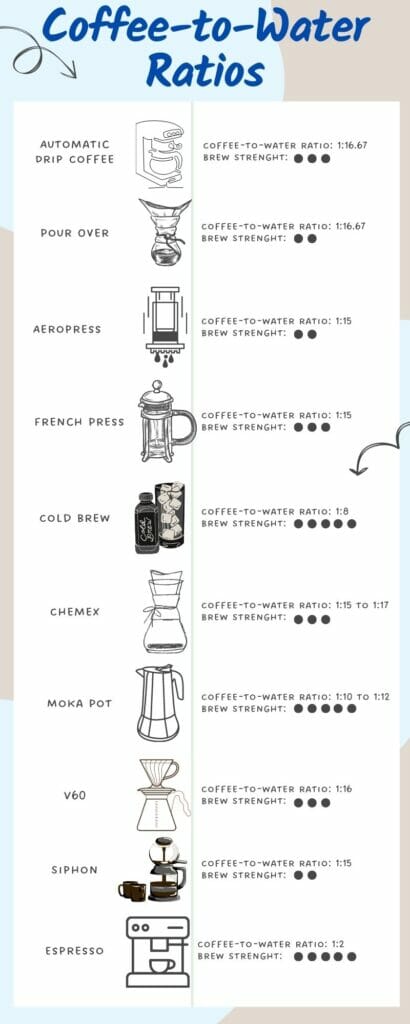
Automatic Drip Coffee Ratio – 1:16.67
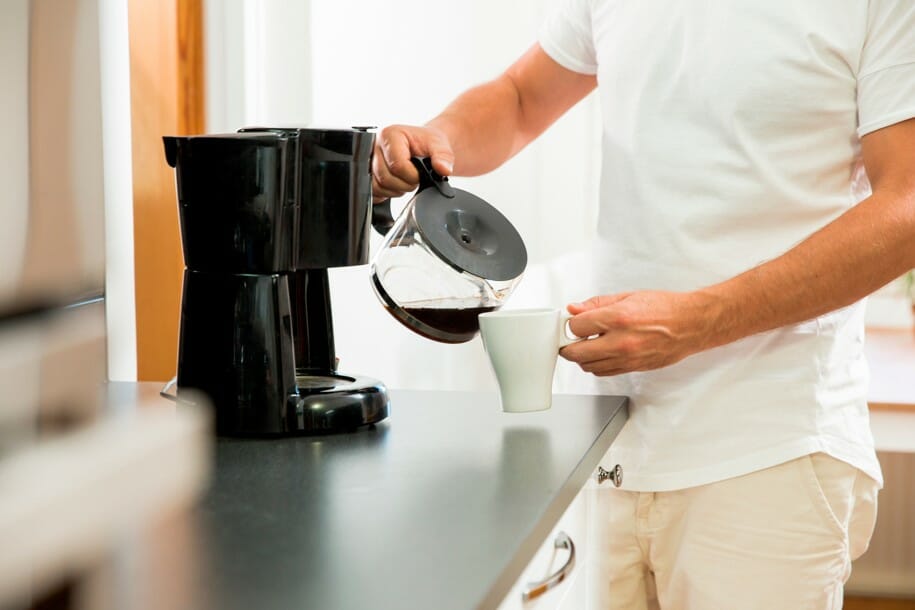
Drip coffee is probably one of the most traditional brew methods out there. Combined with fresh coffee grounds, your cup of coffee will taste fine and flavorful.
The ideal ratio for fine drip coffee is 1:16.67, or 60 grams of coffee to 1000 grams of water.
Pour-Overs Coffee-to-Water Ratio – 1:16.67
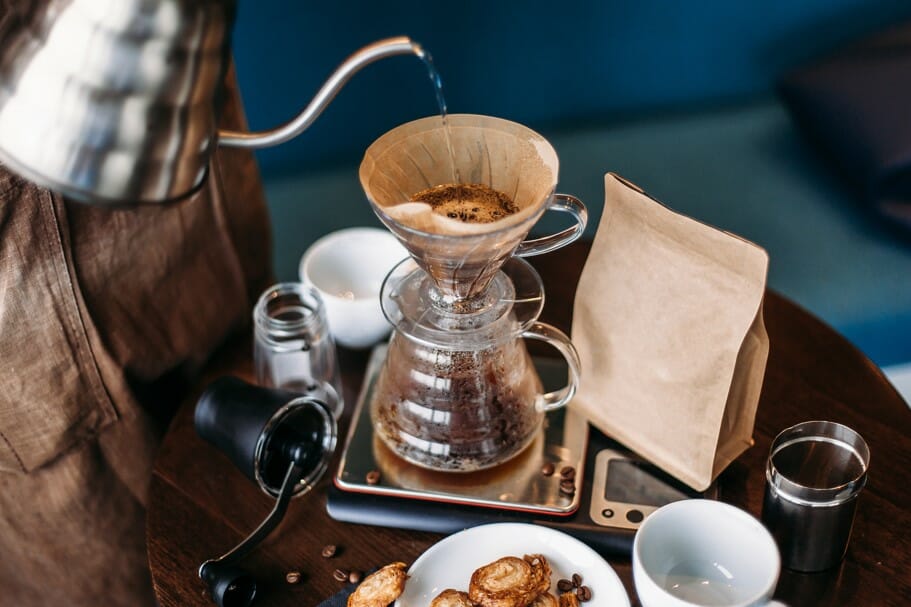
Pour-over coffee is brewed similarly to drip coffee, with the only difference being that in a previous method, you have an auto-drip coffee maker.
To brew a cup of pour-over coffee, you need to heat up water and slowly pour it over ground coffee.
The ratio of 1:16.67 will not make your coffee taste bitter but will give it a strong-enough and aromatic flavor.
For a mouthful cup of pour-over coffee, you can use 12 grams of coffee and 200 grams of water.
Aeropress Coffee-to-Water Ratio – 1:15
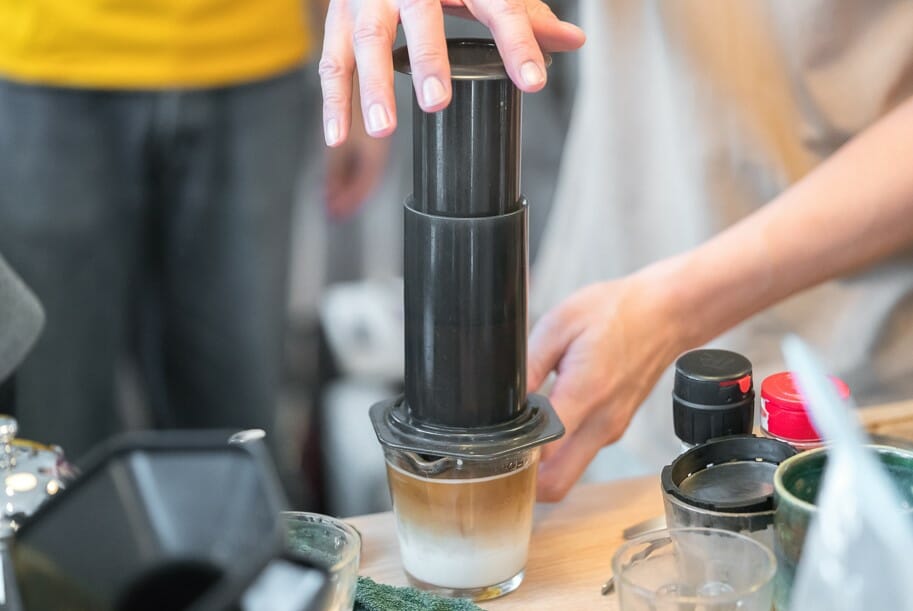
For this method, I would recommend using an inverted technique instead of a traditional one.
Basically, you add coffee to your Aeropress and fill it with the required amount of water, and then flip it upside down with your cup located right under it.
After you add coffee and water to your Aeropress, you also place a paper filter and only then do you invert and press the plunger down. This style of brewing is somewhat similar to the French press but reversed. So, coffee brews and drips into your cup.
The ratio is 1:15, and it will brew you a tasty cup of coffee, not bitter and not watery but just right.
French Press Coffee Ratio – 1:15
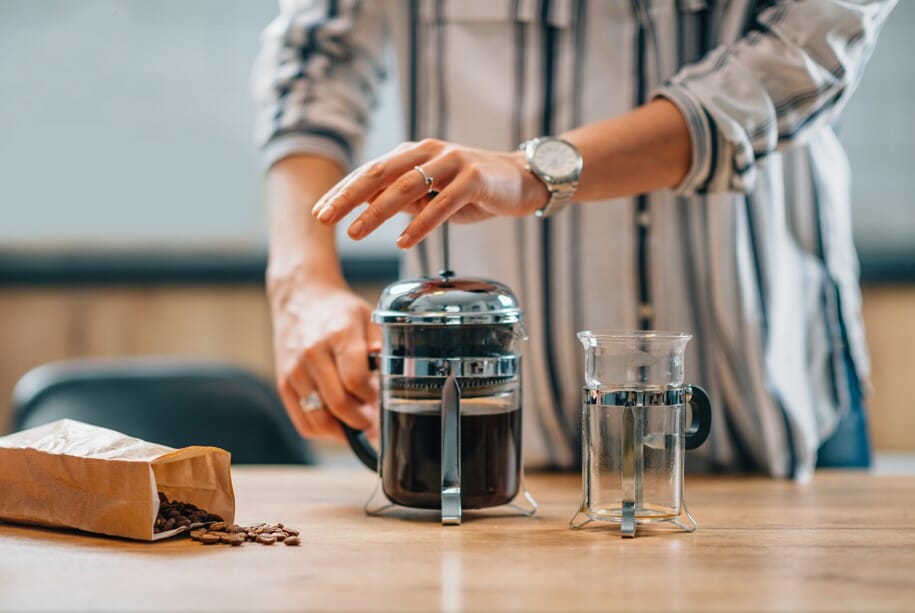
Coffee makers are in love with classic French press coffee. This brew ratio of 1:12 or sometimes even 1:15 will be just enough for a few cups of coffee.
Grab your French press from the kitchen cabinet, place coarsely ground coffee in the bottom, and pour hot water over it. Give it a quick stir and let it steep for a few minutes.
Once you press the plunger down (do it slowly), the robust flavor of the coffee will infiltrate your brew. To get the mouthful of full-bodied flavor, let your coffee steep for at least 4-5 minutes.
The ideal ratio here is 1:15, or about 30 grams of coffee to 450 grams of water.
Cold Brew Coffee-to-Water Ratio – 1:8
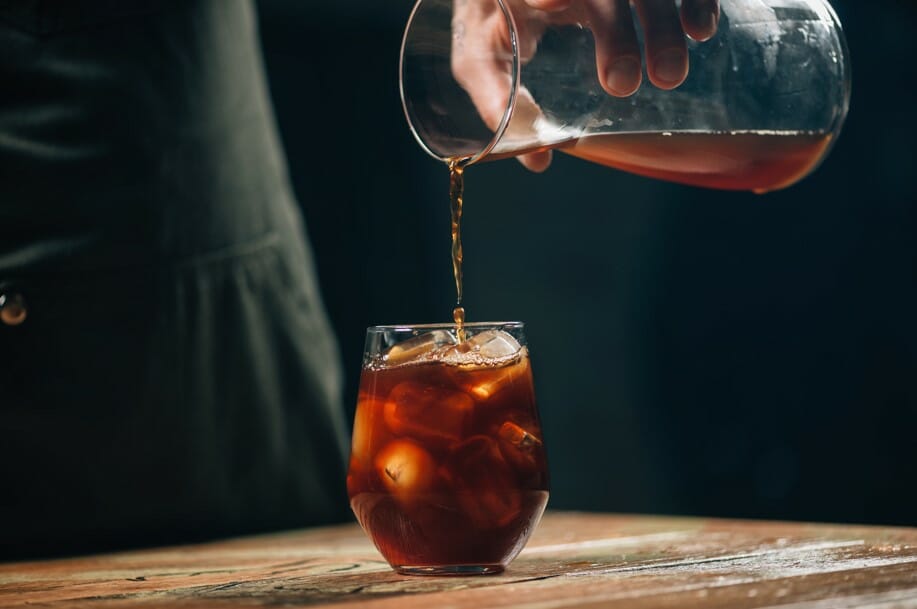
For this brewing method, hot water is replaced with cold or room temperature. Unlike other methods, this one also takes an extended period of time to properly brew – 12-24 hours. The concentrate is later diluted with water or milk to make a cold cup of coffee.
A common ratio is around 1:8, or for example, 25 grams of coffee to 200 grams of water.
Note: The coffee-to-water ratio for cold brew coffee is generally higher than the ratio used for hot brew methods, such as drip coffee or French press. This is because the extended brewing time of cold brew coffee allows more of the coffee’s flavors and oils to be extracted from the beans, so a higher ratio of coffee to water is needed to achieve the desired strength and flavor.
Chemex Coffee-to-Water Ratio – 1:17
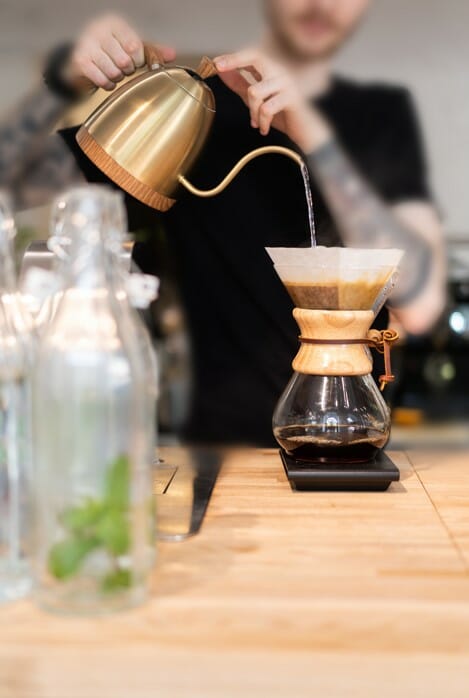
The recommended ratio by Chemex is 1 tablespoon for every 5 ounces of water. However, it brews quite a strong coffee and tastes a bit bitter for some. The advised ratio is 1:15.
If you prefer a milder taste, increase the water ratio up to 17, meaning experiment with which proportion tastes the best for you, from 1:15 to 1:17. Start with 20 grams of coffee and 300 grams of water. Increase the water ratio if the coffee tastes a bit stronger than you like it.
Moka Pot Coffee-to-Water Ratio – 1:12

13 grams of coffee and about 170 grams of water will result in 2 small cups of perfect coffee. The ratio is 1:12, but I’ve heard people like a brew ratio of 1:10, where you measure 20 grams of coffee and 200 grams of water.
V60 Coffee-to-Water Ratio – 1:16
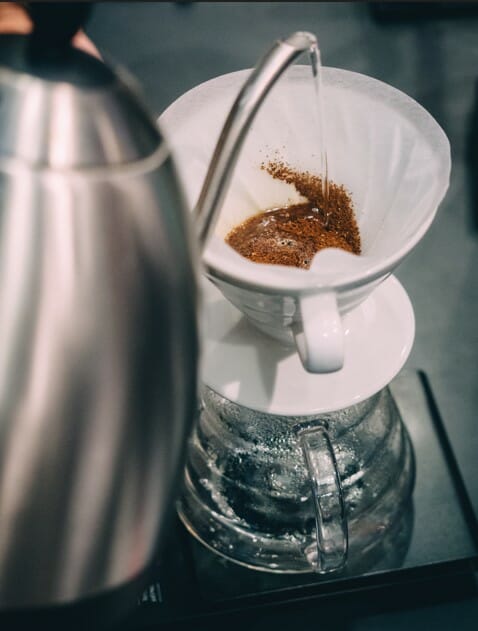
V60 coffee-brewing method is very similar to Chemex – both use a pour-over technique and let the coffee drip into your cup. The only significant difference is (except for the coffee makers) the filter used. The Chemex coffee maker uses a thick paper filter, allowing it to brew clear, sediment-free coffee. Although V60 has a thinner paper filter, it doesn’t mean you get bad coffee – on the contrary, the brew is clear as well.
In fact, some people started using V60 paper filters on the Chemex coffee makers – or vice versa – because the Chemex filters may sometimes be hard to find in local stores.
The recommended ratio for V60 is 1:16, which translates into 15 grams of coffee and 240 grams of water for one cup. Double the measurements to brew two cups.
Siphon Coffee-to-Water Ratio – 1:15
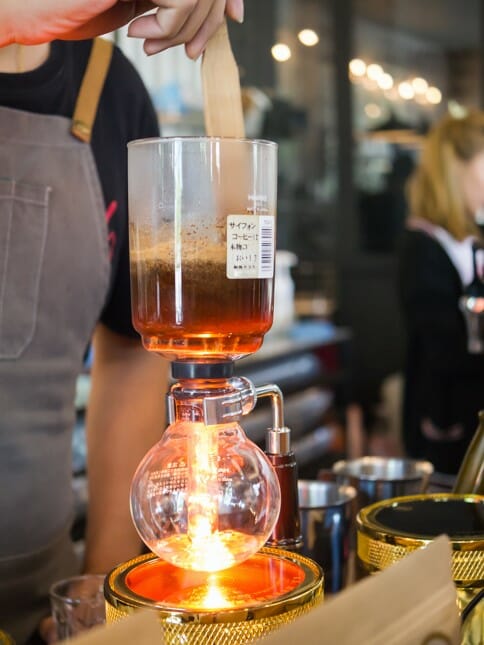
Siphons must be one of the most unique-looking coffee makers. Bring one home and feel like a witch brewing a potion.
The setup is fairly easy, although the coffee makers may look puzzling at first. First, you need to place a filter into the funnel or the upper part of the coffee maker. Next, you need to heat your water and pour it into the lower part now. Once it’s done, attach the upper chamber to the lower one.
If you use an electric siphon, make sure the funnel sits steady and is far inside the lower chamber. On the other hand, if you have a non-electric siphon, you should place the funnel closely on top of the lower chamber and let it sit at an angle.
Next, to start brewing your magical coffee, it needs a heat source. Electric coffee makers work with a single click of a button, but you need to light up a candle burner located right under traditional siphons.
As the water heats up inside the lower chamber and starts building up in the upper chamber, it is time to add your measured coffee to the upper funnel. Give your coffee a stir and let it brew for a few minutes.
The ideal coffee-to-water ratio is 1:15 – a very common proportion for most of the methods, actually. For a siphon, you can grind 27 grams of coffee and preheat 400 grams of water.
Espresso Coffee-to-Water Ratio – 1:2

The optimal coffee-to-water ratio is undoubtedly 1:2. However, it doesn’t mean you have to stick to this proportion. Don’t be afraid to try the equal ratio of 1:1, or else called ristretto, a shot of bitter coffee to give a lasting boost of energy before a long journey or a hard-working day.
If you despise bitterness, why not increase the water ratio and try a 1:4 proportion, or else called lungo, a slightly bigger espresso cup?
FAQs
How many scoops of coffee do I need for 1 cup?
A tablespoon of coffee equals around 10 grams, which is a bit less than you need for a full cup of coffee. The recommended amount is about 10-15 grams (1 ½ to 2 tablespoons) per 6 ounces of water.
Following the standard coffee-to-water ratio of 1:15, you can use 12 grams of coffee to 180 grams of water.
How to calculate ratios?
The quickest way to calculate ratios is to use a free coffee-to-water ratio calculator.
Or you can do the following:
- Let’s say you have 30 grams of coffee and a 1:16 ratio.
- You need to multiply the amount of coffee beans by chosen ratio.
- 30 x 16 = 480
- You need 480 grams of water to brew coffee with 30 grams of ground coffee beans.
How much ground coffee do I use for 2 cups of water?
As the Golden Ratio states, you need to follow the 1:15 ratio. You will need approximately 20 grams of ground coffee and 300 grams of water to make 2 cups of coffee.
How much ground coffee do I use for 4 cups of water?
For measuring the proportion, we will follow the Golden Ratio (1:15). For one cup, you need about 10 grams of coffee, so it makes more or less 40 grams for 4 cups. Multiplied by 15, you need 600 grams of water.
How much ground coffee do I use for 6 cups of water?
For 6 cups of coffee, you need 60 grams of freshly roasted coffee and 900 grams of water.
How much ground coffee do I use for 8 cups of water?
For 8 cups of coffee, you will need to grind approximately 80 grams of coffee and 1200 grams of water.
How much ground coffee do I use for 12 cups of water?
I am not sure if there is a coffee maker that is able to brew 12 cups of coffee at once, but for those curious minds, the answer is 120 grams of coffee and 1800 grams of water.
Final Word
Coffee is a morning ritual, a revitalizing drink, and is just better than ta in so many ways. It does have its pros and cons. The cons are the amount of time and effort you spend preparing a cup of coffee. The pros are the amount of time and effort you put into making a mouthful cup of aromatic coffee.
Coffee devotees understand the best. Brewing the best coffee requires practice and freshly roasted and ground coffee beans. It simply doesn’t taste the same with old beans – trust me.
All in all, you can follow the Golden Ratio for most of the brew methods but remember to experiment with the proportion to find your personal ratio.

Barry Konkin is the founder of HotShot Coffee Sleeves. With over 30 years experience in commercial offset printing, Barry utilized his diverse printing background and creativity in developing new coffee sleeve designs that were granted Patents in both the USA and Canada. Barry’s goal is to assist businesses with brand promotion through the use of high quality custom printed cup sleeves. With an understanding of your marketing and operational objectives, Barry can recommend the ideal coffee sleeve solution for you.


